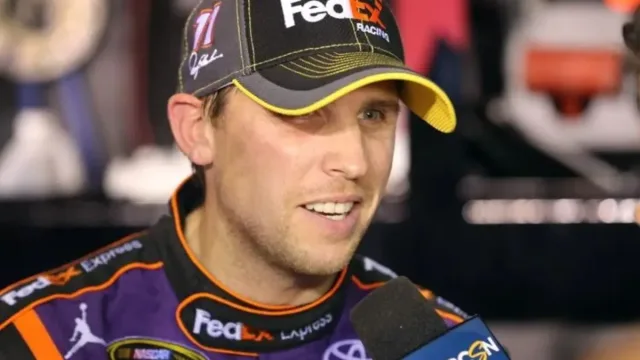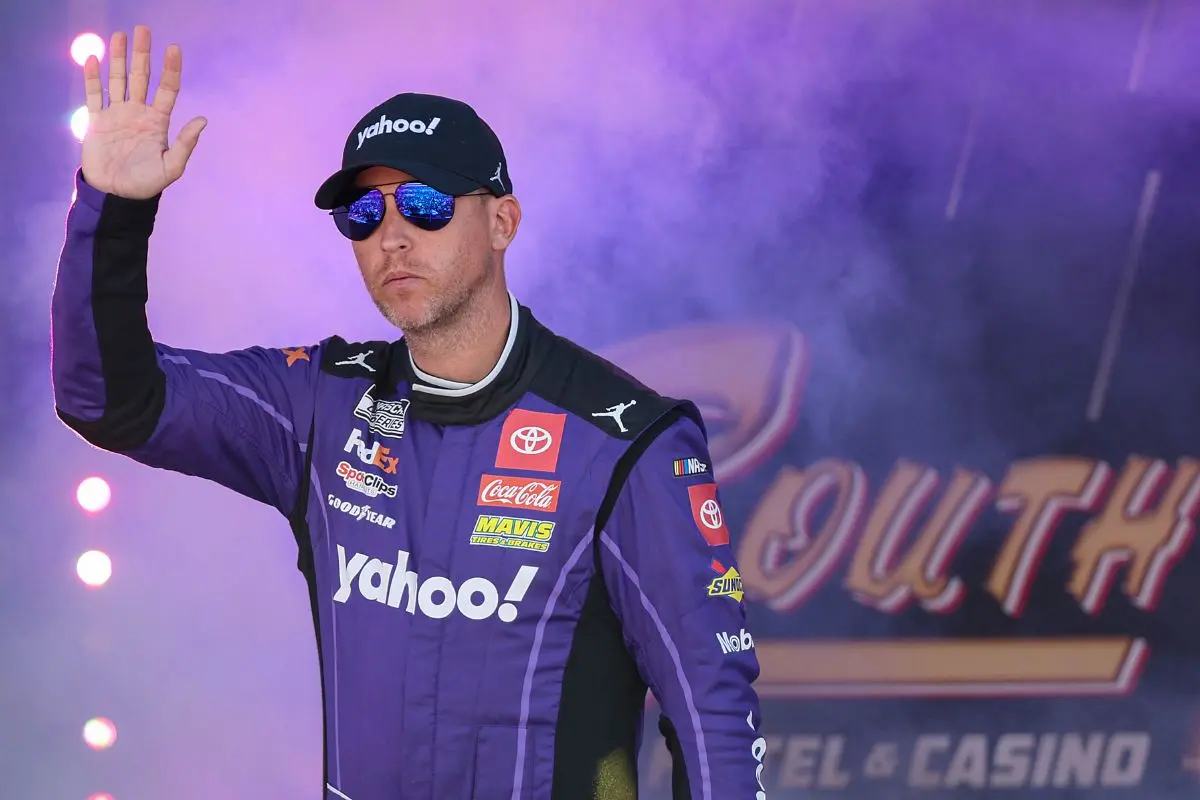Denny Hamlin‘s top 5 finish goes in trash, marking a major setback in his season. Despite several strong finishes, he started as a title contender but saw his performance drop significantly in important races due to mechanical problems and poor decisions. The crash at Martinsville showed these struggles, damaging both his car and the team’s spirit. As his speed faded, so did his chances for the NASCAR championship, leading to disappointment for fans and analysts alike. This third straight failure to get past the Round of 8 reveals deeper issues within his team.
Key Highlights
- Denny Hamlin’s season featured promising top-five finishes early on in NASCAR, raising expectations among fans and analysts.
- A significant crash during practice at Martinsville severely impacted his vehicle’s performance and team morale in the NASCAR series.
- Late-season mechanical issues and strategic errors in NASCAR led to disappointing race outcomes, thwarting his championship aspirations.
- Inconsistent speed among Toyota cars hindered Hamlin’s performance in NASCAR, leading to frustration and miscommunication within the team.
- Ultimately, Hamlin’s inability to advance past the Round of 8 in NASCAR marked a disastrous end to his season, despite early successes.
Denny Hamlin’s Challenging NASCAR Weekend at Martinsville
Denny Hamlin’s weekend at Martinsville was indicative of the tumultuous season that has plagued his campaign, highlighting the relentless challenges he faced as he sought to secure a spot in the final four. The onset of difficulties began with a crash during the practice run, which not only hampered his vehicle but also intensified the stress on his team. The #11 Toyota Camry, a staple of Hamlin’s competitive arsenal, required extensive repairs, demanding that the crew work tirelessly around the clock to restore it to racing condition.
Starting the race from the rear of the field, Hamlin confronted an uphill battle that tested his skill and resolve. The Martinsville track, known for its tight turns and competitive nature, left little room for error, making his challenge even more formidable. It was a demonstration of his racing skill that he raced with tenacity, battling through the field and showcasing his ability to navigate adversity.
However, the accumulated weight of the season’s setbacks loomed large, casting a shadow over his performance. Hamlin’s efforts were commendable, but they highlighted the considerable obstacles he faced throughout the year. The apex of mechanical failures, tactical missteps, and fierce competition had set the stage for a disappointing outcome.
As he navigated through the race, it became increasingly clear that the odds were stacked against him. Ultimately, Martinsville served not just as another race, but as a poignant reflection of a season rife with challenges and unmet expectations.
The Struggle for NASCAR Championship Qualification
Securing a spot in the NASCAR championship race has proven to be a formidable challenge for Hamlin and his team, as they grappled with consistently disappointing performance throughout the season. Despite the #11 car showing promise with finishes that often placed them within the top five, this was ultimately insufficient to achieve their primary objective: qualification for the championship event in Phoenix.
The narrative of Hamlin’s season has been characterized by a sobering admission of shortcomings. While the car’s ability to maintain a competitive pace in the top tier of finishers hinted at a potential for success, the underlying issue was an undeniable lack of speed. This deficiency not only stymied their ambitions but also served as a striking reminder of the razor-thin margins that separate championship contenders from mere participants.
Hamlin’s frank acknowledgment of these limitations reflects a broader truth in NASCAR; speed is a non-negotiable element in the pursuit of championship glory. The team’s inability to translate solid finishes into qualifying points created a gap that proved insurmountable as the season progressed.
As the dust settles on another season, Hamlin’s expedition emphasizes the relentless nature of the sport and the critical importance of speed in the quest for championships. The challenge remains: how will he and his team recalibrate to guarantee that next season does not mirror this year’s disappointments?
Speed Issues During the Race
Hamlin’s struggles extended beyond mere qualification issues, manifesting acutely during race conditions where speed became a critical factor. Despite displaying the fastest lap times during practice, where the #11 Toyota Camry outpaced its competitors, Hamlin found himself unable to replicate this performance in the race.
Initially, he appeared to carry over that momentum, making notable gains in stage 1 as he passed multiple cars, positioning himself favorably. However, the fleeting success was overshadowed by a troubling inconsistency that would soon derail his efforts.
As the race progressed, the anticipated speed advantage diminished, raising questions about the car’s setup and tire management. The disparity between practice and race conditions is not uncommon, but for a driver of Hamlin’s caliber, the drop in speed was particularly alarming. It suggested deeper mechanical or tactical issues that the Joe Gibbs Racing team would need to address.
The climax of these speed issues became painfully evident when Hamlin crashed into the wall, compromising the integrity of his vehicle and effectively ending his race. This incident served as a glaring reminder of how quickly fortunes can change in NASCAR.
While he initially displayed potential, the inability to maintain that speed under race conditions ultimately contributed to a disappointing resolution to his season. The contrast between practice excellence and race performance highlights the complexities of competitive racing, where every detail can be the difference between victory and disaster.
Post-Race Reflections on Performance
While Denny Hamlin displayed a commendable balance in his car’s setup, the post-race analysis revealed a clear reality: the #11 Toyota Camry lacked the speed necessary to compete effectively against its rivals. This deficiency became glaringly evident during the alternate stage, where despite implementing an alternative tactic that mirrored race winner Ryan Blaney’s, Hamlin was unable to maintain his position against the formidable charges of Chase Elliott and Kyle Larson.
In his post-race interview with FrontStretch, Hamlin openly acknowledged the limitations of his vehicle, emphasizing the need for “more speed, more capability.” His reflections highlight a critical aspect of competitive racing: speed is the currency that defines success. While his car’s balance was satisfactory, it was insufficient to close the gap with front-runners, revealing a noticeable contrast in performance.
“Just more speed, more capability. I just felt like our balance was pretty good; we were just not fast enough to run with the other cars. Obviously we struggled with speed today, and that was not ideal, but we just gotta get better.”
“I’m not really sure; I mean, certainly things change when you get out there and put all 36 cars out there and rubber that’s on the track. Conditions, you know from sun to night so you never know. Our car was good yesterday, but still, it looked like the Hendrick cars and the 12 really just were a little faster.” – denny hamlin
This season marks the third consecutive year in which Hamlin has found himself unable to advance past the Round of 8 in the NASCAR Next-Gen era, raising questions about both the car’s performance and the team’s tactical decisions.
Team Dynamics and Teammate Struggles
How does a team’s performance reflect the individual struggles of its drivers? In the case of Denny Hamlin and his teammate Christopher Bell, their inability to advance in the NASCAR playoffs emphasizes the intricate link between team dynamics and personal performance. Despite promising setups, both drivers faced distinct challenges that not only hindered their results but also illuminated potential fractures within the team.
Key factors contributing to their struggles include:
- Inconsistent Speed: The Toyota cars, particularly the #20 of Bell, failed to match the pace of competitors like the Hendrick team. This disparity can create frustration among teammates and influence their approach to races.
- Stress and Decision-Making: Bell’s ill-fated last-lap maneuver, evocative of Chastain’s daring move, indicates the stress felt to secure results. Such high-stakes decisions can lead to mistakes that reflect poorly on team cohesion.
- Communication Gaps: The lack of effective communication during critical moments can exacerbate individual errors, pushing drivers to act independently rather than collaboratively.
- Safety Concerns: NASCAR’s swift penalty against Bell for safety violations suggests a broader team culture that may not prioritize risk management, further complicating the dynamics among drivers.
View this post on Instagram
“We’ve met with the industry; we met with the drivers, and everyone to man decided that was not something we could tolerate. We didn’t want that move to be accepted.”
“We had language in the rulebook. It is a safety violation, and when we saw the 20 car, that’s exactly where we went. We looked at it a couple of different times just to make sure, and that was the call. And that’s to protect our competitors as well, our fans.” – Elton Sawyer
News in Brief: Denny Hamlin’s Top 5 Finish Goes in Trash
The climax of Denny Hamlin’s season at Martinsville exemplifies the unpredictable nature of competitive racing. Despite showcasing potential for a top-five finish, mechanical setbacks and tactical miscalculations ultimately thwarted championship aspirations.
The interplay of team dynamics and individual performance further complicated the scenario, highlighting the intricate balance required for success within the sport. As the season concludes, Hamlin’s experience serves as a poignant reminder of the fine line between victory and disappointment in NASCAR.
ALSO READ: Denny Hamlin Admits Championship Dreams Are Dead as Martinsville Reality Sets In



